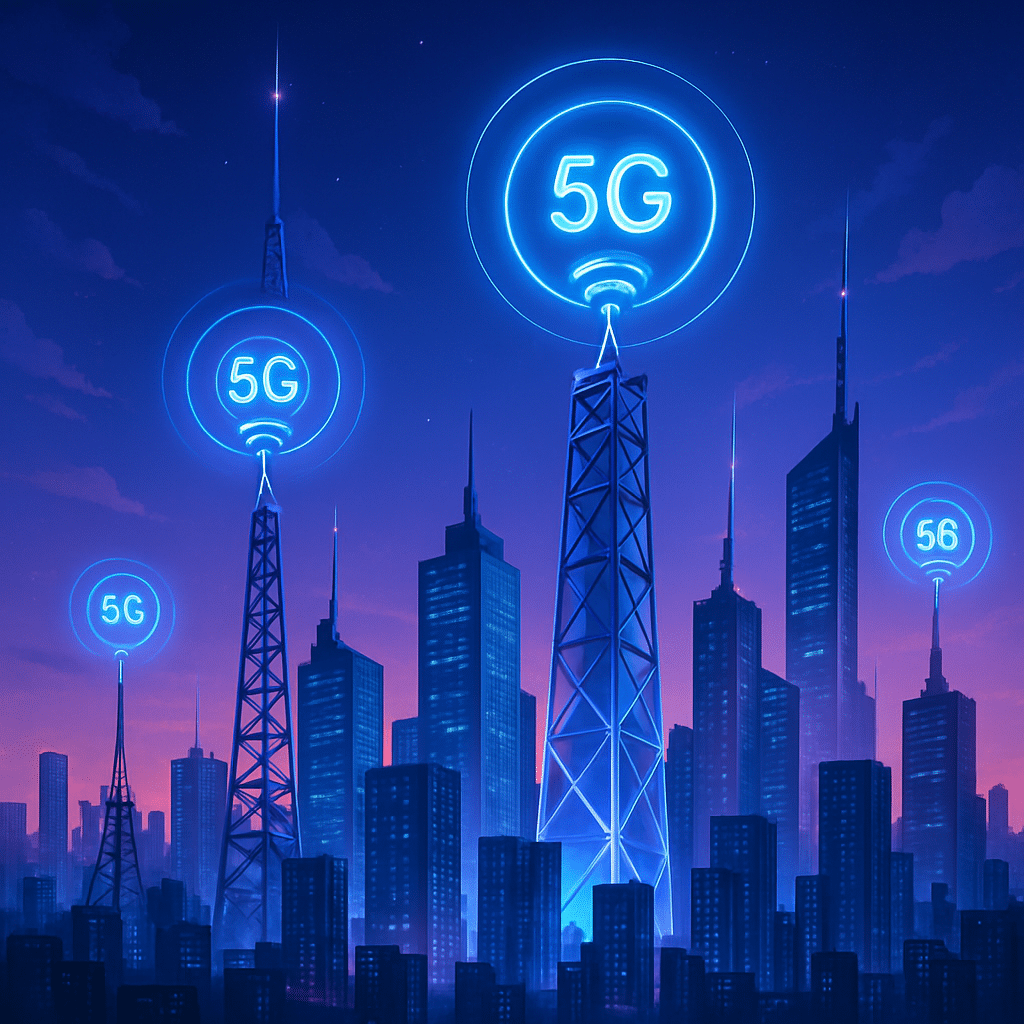5G vs 6G: What the Future of Connectivity Means for You
Introduction: The future of connectivity is unfolding rapidly as 5G wireless networks become widespread and researchers turn their eyes toward 6G. For consumers and businesses, this transition means faster internet speeds, lower latency, and new possibilities for global communication. In 2025, 5G technology is delivering unprecedented mobile data performance, while the potential of 6G networks promises to revolutionize how we stay connected in the next decade. This article explores 5G vs 6G, highlighting what each generation offers and what the future of connectivity could mean for you.
Understanding 5G Technology Today
5G is the fifth-generation mobile network technology that is currently being rolled out worldwide. It builds on 4G LTE but offers much higher data rates and significantly lower latency. With 5G technology, users can experience download speeds multiple times faster than 4G – in real-world conditions, often around 100–1000 Mbps (depending on coverage), whereas 4G was typically tens of Mbps. This jump in internet speed means that downloading large files or streaming high-definition video becomes almost instantaneous on 5G. Just as importantly, 5G networks greatly reduce latency (the lag or response time), enabling near real-time responsiveness. This is crucial for applications like online gaming, video calls, or emerging technologies such as autonomous drones and vehicles that require split-second communication.
Another advantage of 5G is its capacity: it can support far more devices in the same area than previous networks. That enables the growing Internet of Things (IoT) – everything from smart home appliances to connected sensors in cities – to all stay connected without overwhelming the network. The future of connectivity enabled by 5G is already visible in some areas: for example, advanced telemedicine trials have used 5G to perform remote surgeries with minimal lag, and smart factories are leveraging 5G to connect robots and machinery for instant coordination. These developments show that 5G technology is not just about faster phone internet, but a foundation for new innovations in many industries.
What 6G Networks Promise
Even as 5G continues to expand, research has begun on sixth-generation (6G) networks. While 6G standards are still being defined and 6G isn’t expected to roll out until around 2030, early goals suggest it will dwarf 5G’s capabilities. 6G networks are aiming for astonishing data rates – potentially up to 1 terabit per second (Tbps) in some scenarios. That is about 1,000 Gbps, which could be 100 times faster than the already swift 5G. To put it in perspective, downloading a full-length HD movie on 5G might take a few seconds; on a mature 6G network, it could be almost instantaneous, even for much larger 8K or holographic videos. Latency in 6G is expected to be ultra-low (perhaps below 1 millisecond), making communications virtually instantaneous.
The future of connectivity with 6G also means networks that are more intelligent and adaptive. 6G will likely utilize advanced technologies like terahertz spectrum and AI-driven network management to dynamically optimize connections. This could result in a seamless global communication fabric where your devices stay at top speed whether you’re in a crowded city or a remote village. Importantly, 6G aims to integrate communication with computing and sensing – for example, 6G devices might also serve as environmental sensors or offer precise localization services far beyond GPS. With global mobile data traffic expected to multiply in the coming years, 6G will be designed to handle that surge with ease, ensuring everyone and everything can be connected reliably.
How the Future of Connectivity Will Affect You
For the average person, the evolution from 5G to 6G will bring about noticeable changes in everyday life. With 5G, many people are already enjoying improvements like smoother streaming, lag-free video calls, and better connectivity in crowded areas (like stadiums or concerts where 4G often struggled). As 5G technology becomes the norm, we’ll see more services such as cloud gaming (playing high-end video games via streaming rather than a console) become mainstream thanks to the fast speeds and low latency. Smart home devices and wearables will also work more seamlessly together on 5G networks, since the network can handle many devices communicating at once.
Looking further ahead, 6G networks could unlock applications that seem like science fiction today. Holographic communications, for example, might become feasible – imagine having a lifelike 3D hologram meeting with family or colleagues in real-time, which would require massive bandwidth that 6G could provide. Augmented reality (AR) and virtual reality (VR) experiences would become far more immersive and mobile when the wireless connection can transmit huge amounts of data with negligible delay. Autonomous vehicles could communicate with each other and with city infrastructure in real time, improving transportation safety and efficiency. Even areas like education and healthcare stand to benefit: with 6G, a teacher could virtually teleport a class to historical sites via AR, or doctors could monitor patients remotely with ultra-reliable, instant feedback from medical devices.
In short, the future of connectivity with 5G and 6G means our digital experiences will be faster, richer, and more integrated into daily life. Of course, building out these advanced networks globally will take time and significant investment. There will also be challenges, including ensuring coverage is broad (so rural areas aren’t left behind) and dealing with higher-frequency signals’ shorter range (which means many more small cell towers for complete 5G/6G coverage). However, the trajectory is clear: each generation of wireless technology brings us closer to a world where high-speed, ubiquitous connectivity is the norm, enabling innovations that make our lives easier, safer, and more enjoyable.

FAQs on 5G and 6G
Q: What’s the difference between 5G and 6G?
A: 5G is the current generation of wireless network technology, while 6G is the next generation still in development. The main differences will be speed and latency: 6G is expected to be much faster than 5G (potentially 10–100 times faster) and have even lower latency. 6G may also integrate new technologies (like advanced AI and sensing capabilities) into the network. In practical terms, 5G already allows high-definition streaming and quick downloads; 6G will build on that to enable things like instant downloads of enormous files, ultra-realistic VR/AR, and seamless connectivity for massive numbers of devices.
Q: How fast is 5G compared to 4G, and how fast could 6G be?
A: 5G is significantly faster than 4G. In optimal conditions, 4G LTE might offer around 50–100 Mbps speeds, whereas 5G can reach several hundred Mbps or even over 1 Gbps in some cases. For example, downloading a movie that might take minutes on 4G could take only a few seconds on 5G. 6G, on the other hand, aims for speeds on the order of terabits per second. That means 6G could be dozens of times faster than 5G. However, 6G won’t be here until around 2030, and those extreme speeds will likely take time to materialize for everyday users.
Q: When will 6G networks become available?
A: 6G networks are expected to start rolling out around 2030. Right now, 5G is still expanding worldwide. 6G is in the research phase—companies and standards bodies are exploring what 6G will look like, but it will be several years before it’s ready for commercial use. Even after the first 6G networks launch, it will take time to build infrastructure and wide coverage. So for now and the next several years, 5G will be the state-of-the-art network technology, with 6G on the horizon later in the decade.
Q: Will my current devices work on 5G or 6G?
A: To use 5G, you need a 5G-capable device (many newer smartphones have 5G support). Older 4G-only phones won’t be able to connect to 5G networks, though they will still work on 4G. As for 6G, today’s devices cannot support 6G – when 6G arrives, new devices will be built with 6G radios. The good news is that 5G networks are generally backward-compatible, meaning your 4G phone can still get service (it will just use 4G). When 6G comes, 5G devices will likewise fall back to 5G or 4G if 6G isn’t available. You’ll need new hardware to take advantage of 6G’s full capabilities.
Q: Are there health concerns with 5G or 6G signals?
A: Scientific consensus so far is that 5G is safe. 5G uses radiofrequency (RF) waves, similar to previous generations but at higher frequencies for some bands. These are non-ionizing radiation, which means they do not damage DNA like X-rays or UV light can. International health organizations and regulators have safety guidelines that telecom companies must follow, keeping RF exposure below harmful levels. The move to 5G has prompted extensive studies, and no credible evidence has been found that 5G causes health issues. 6G will also use RF waves (potentially even higher frequency), and it will undergo similar scrutiny. The key point is that whether it’s 3G, 4G, 5G, or future 6G, the power levels and frequencies are regulated to be within ranges considered safe for the public.
Conclusion
The future of connectivity promises to reshape our digital lives. With 5G technology already rolling out, we are seeing the benefits of faster speeds and more reliable connections, laying the groundwork for the next leap to 6G networks. Each generation of wireless technology – from 5G vs 6G and beyond – brings huge improvements that open the door to new possibilities, from immersive virtual experiences to smarter cities and healthcare.
Importantly, 5G and 6G aren’t about one replacing the other overnight. 5G will serve as the backbone of connectivity for years, even as 6G is developed in the background. In time, 6G will build on 5G’s foundation to provide an almost ubiquitous, instantaneous network experience. For consumers, that means a future where buffering and lag are minimal, and innovations that rely on ultra-fast, low-latency connections become everyday realities. As we look ahead to 2030 and beyond, staying connected will be easier and more seamless than ever, enabling advancements that will touch every aspect of our lives for the better.
Further Reading
- Ericsson – What is 6G?
Insights into 6G research, goals, and expected rollout around 2030.
👉 ericsson.com/en/reports-and-papers/6g - Qualcomm – What is 5G?
Comprehensive breakdown of how 5G works and its impact on industries.
👉 qualcomm.com/5g/what-is-5g - ITU (International Telecommunication Union) – Towards 6G
Global telecom standards body overview of 6G research directions.
👉 itu.int/en/ITU-T/focusgroups/6g - GSMA – The Mobile Economy Report
Annual industry report with stats and forecasts on 5G and future networks.
👉 gsma.com/mobileeconomy - IEEE Spectrum – What Will 6G Be?
Technical analysis of potential 6G features like terahertz spectrum and AI integration.
👉 spectrum.ieee.org/what-will-6g-be
